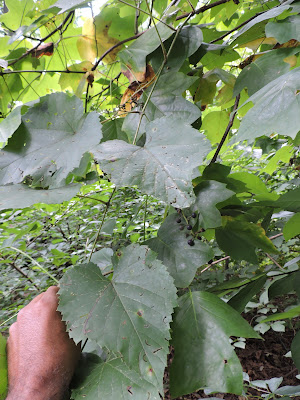 |
| Riverbank Grape (Vitis riparia) is among the most common of our wild grapes. |
Wild Grapes (Vitis spp.) are an often misunderstood, but extremely valuable plant in our local woods. There are over 60 different species in North America, with 11 in Virginia, and 7 in the DC area. These woody vines can grow over 100ft in height and some varieties (granted in Europe) are known to live over 400 years. Most older vines have exfoliating bark and forked tendrils which help identify them. There are many species of birds that utilize the shredded bark to build their nests and many who favor nesting in the tangles themselves.
There are many people who mistakenly think that grape vines are harmful to trees. Others mistake them for the invasive nonnative vine Porcelainberry (Ampelopsis brevipedunculata) which can smother and shade out native plants, and while removing it, accidentally destroy the grapes. One way to tell the difference is that Porcelainberry has white pith in its stems rather than the brown of grapes.
 |
| Porcelainberry is easily mistaken for grape when not in fruit, but is not edible and is an invasive nonnative vine. |
Native grape vines are rarely damaging and will not kill healthy trees. They do not strangle and constrict the tree trunks (girdling them) like many nonnative vines who did not evolve with them actually do. Let's recall that if they really did kill off the native trees, they would have done so a long time ago. So these native vines get an undeserved bad rap and are actually a beneficial and integral part of the woodland edges.
People have had a long association with grapes of course. Viticulture has been around and tied with civilization and even religion for centuries. When the Norse first reached North America there were so many grapes that they referred to is as Vinland. Survivalists know that cutting a section of vine can yield quite a bit of watery sap that can be used as an emergency water source. Parts of Virginia are well known for their domestic grape production and parts are definitely wine country.
 |
| Muscadine Grapes (Vitis rotundifolia) or Scuppernong are among the biggest native grapes and is the most cultivated of the native grapes. |
Native American Indian tribes have of course always used grapes as well, not just for food, but for a multitude of other reasons. Noted ethnobotanist Daniel Moerman recorded many of these uses. The Iroquois for example used grape parts to treat anemia, stomach troubles, kidneys, urination issues, and even chewed the leaves to treat such mundane things as hiccups. The Menominee squeezed grapes to use as an eye wash. The Chippewa, Delaware, and Oklahoma all used it to wash hair (and some to treat pulmonary problems, diarrhea, rheumatism, and diabetes). The Mohegan, Seminole, and Shinnecock all used various grape species for dealing with headaches. The Cherokee thought parts of grape could deal with diarrhea, stomach ailments, liver problems, blood disorders, urinary irregularities, and even used the wilted leaves to draw soreness from breasts after birth. The Choctaw treated fevers with grape and used the sap to induce lactation in new mothers. The Seminole also used it for stomach aches, fevers, as a religious emetic, and as cordage for such things as coffin lashings.
During the Civil War, Dr. Francis Porcher was tasked with finding wild alternatives to goods no longer available to the Confederacy due to war and blockades. He did an amazing job compiling these uses. Most of his book entries were short and to the point, but he devoted several pages to uses for grapes. These included use as a dye, but he devoted most to the production of wine in great detail.
Animals of course make the most use of these native vines. While many mammals eat the fruits, helping to disperse the seeds, over 100 bird species have been documented eating grapes. They are a favorite of many of them. Another 79 caterpillar species have been documented using grapes as host plants to feed on, especially sphinx moths. These of course then feed many birds, 96% of which feed their young insects and preferring caterpillars over all others. All 17 of the bats found in the region also eat insects, and most favor the moths these caterpillars turn into as well.
 |
| The daytime flying wasp mimic Grapeleaf Skeletonizer Moth is one of the many that feed on grape. |
I've eaten many a wild grape myself, knowing the best fruiting takes place along edges where the vine gets sun. They are much smaller than domesticated varieties and vary widely in flavor. Some, such as Frost Grapes, are much better tasting after they're hit by frost. Some are are tart and others sour, but I always enjoy trying them. So appreciate the wild grapes that grow in our parks and woodlands, knowing they have a rich history of uses by both humans and wildlife.
 |
| Frost Grape or Winter Grapes (Vitis vulpina) |
 |
| Frost Grapes taste much better after they've been touched by frost and can be eaten (even as wild raisins) even well into winter, giving them their other common name of Winter Grape. |
Where can we find and forage for these lovely looking native grapes?
ReplyDeleteI'm so glad you sent out this post Alonso. Very helpful, since I have not always paid good attention to which vine I was pulling. So many great uses. Thanks for the numbers of mammals, insects, moths, caterpillars, birds!
ReplyDeleteThanks folks, indeed wild grapes are often under appreciated.
ReplyDelete